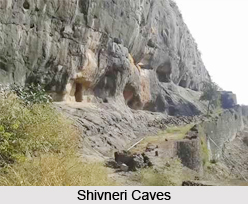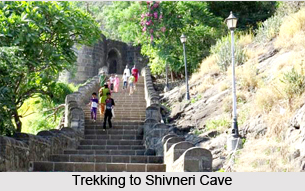 Shivneri Caves in Junnar region, Maharashtra contain 50 rock-cut temples of the religion that was created around 1st - 3rd century AD. The region of Junnar consists of almost 200 caves that are segregated into four groups, Tulja Lena, Lenyadri Caves, Manmod Caves and Shivneri Caves which is in the south-west side. Some of the caves contain traces of paintings from the ancient period and also paintings from the later 17th century.
Shivneri Caves in Junnar region, Maharashtra contain 50 rock-cut temples of the religion that was created around 1st - 3rd century AD. The region of Junnar consists of almost 200 caves that are segregated into four groups, Tulja Lena, Lenyadri Caves, Manmod Caves and Shivneri Caves which is in the south-west side. Some of the caves contain traces of paintings from the ancient period and also paintings from the later 17th century.
Temples of Shivneri Hill
The rock cut temples of Shivneri Caves in Maharashtra, which are Buddhist monasteries, were mainly made in the Hinayana tradition, almost 2000 years ago. Most of the caves are rather dreary and only a few of the caves have remnants of ancient paintings. The caves are formed in four condensed groups, one of the group located on the western side, faces the Nana valley, while two others on the eastern side, faces Junnar and another group is on the southern wall.
First group of Shivneri Caves
There are 12 caves in the first group that are situated in the lower areas on the southern part of the hills. Cave 1 is a vihara or monastery, which contains a verandah, reservoirs and cell. Cave 2 contains a chapel and pillared verandah along with a hallway, which houses a shrine. Cave 3 and 4 are also viharas and cells. Cave 5 also has similar structure and contains remains of a statue of Lord Ganesha. Cave 8 had a vast hallway where as Cave 9 and 10 are undersized viharas that contains cell. Cave 11 is a dwelling for the Buddhist monks and has cell and cisterns. Cave 12 also has a cell.
Second group of Shivneri Caves
The second group of the Shivneri caves have 25 caves that are situated on the south-eastern side of Shivneri Hills. The final twelve caves are further grouped into Bara Gadad. Cave 14 has a duplex structure and the ground floor is divided in 3 parts, hallway, verandah and a series of cells, which was assumed to store cattle. There is a big hall and a verandah on the upper floor. The floor has a stunning view of the surrounding location. Cave 15, 16 and 17 contain a verandah. Cave 18 also has a cell and a reservoir. It also contains a stairway, decorated with images of Ganesha, Batuk and Goddess Durga, that goes to the hilltop. But in the later period most part of the stairs were damaged by the Muslims. Cave 21 contains a vast vestibule, with polished walls, floor and ceiling. Cave 22 is a vihara and has a hallway, verandah and cells. It was later modified into a Hindu shrine with remnants of an image of Lord Ganesha.
Cave 23 has a vestibule and vestibule that contains the sculpture of a carved horse in a saddle. The Bara Gadad begins from Cave 24, which is a large monastery and houses a verandah and cell. Caves 25 and 26 also have cells that have remains of paintings. Cave 27 is also a vihara and has a cell and verandah. There is also a dome shaped shrine. Cave 28 has cells and the ceilings that have remains of painting in black, yellow and white colours. Cave 29 is joined with the previous cave, and contains verandah, cistern and cells. Cave 30, 31, 32, 33, 34, 35 are mainly viharas, and some contain verandah and cell. Some of them are plastered and painted. Cave 36 is a Chaitya Griha and is the chief shrine here. It also has a verandah and a lobby area. There is also a shrine of dagoba that is styled according to the Gotamiputra period. The ceilings in the lobby have paintings in square and circular pattern, as well as designs of flowers. Yellow, white, red, and black are the dominant colours in these paintings. Cave 37 has a partly ruined verandah.
Third group of Shivneri Caves
There are 6 caves in this particular group that are situated on the west side of the cliff of Shivneri hill. The ceiling of the cell in Cave 38 has remains of painted plaster. Cave 41 is a monastery and contains a hall, verandah, cells and reservoirs. Cave 42 has a cell and the ceiling is plastered and painted. Cave 43 has a pillared verandah and a vast hallway. The ceiling contains remains of ancient paintings that are preserved well.
Fourth group of Shivneri Caves
The caves in the fourth group are southward facing and consist of seven caves. Cave 44, which was originally a Buddhist shrine, has been converted into a Hindu shrine and contains a hallway and large verandah with tow stone walls on the sides. In the hallway, there is an altar of Shivabai, Hindu goddess. There are remnants of Maratha painting on wooden beam in the entrance. The painting is from the 17th century and portrays Vishnu, Brahma, Shiva and Sarasvati. There is also a painting of Parvati and Shiva that is partly ruined. Another painting depicts the tales of the epic Ramayana. There also Buddhist paintings inside the shrine. Cave 45, 46 and 47 are viharas and contains verandah and cells. Cave 48 has a pillared hall and an inscription with a swastika. Cave 50 is a big chaitya and has a hallway, pillared verandah and shrine.



















